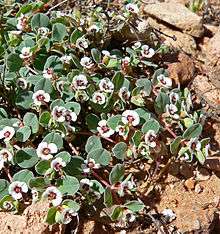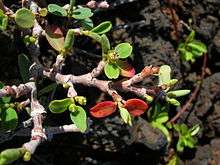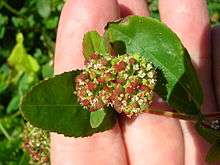Chamaesyce
| Chamaesyce | |
|---|---|
 | |
| Chamaesyce hypericifolia leaves and flowers | |
| Scientific classification | |
| Kingdom: | Plantae |
| (unranked): | Angiosperms |
| (unranked): | Eudicots |
| (unranked): | Rosids |
| Order: | Malpighiales |
| Family: | Euphorbiaceae |
| Subfamily: | Euphorbioideae |
| Tribe: | Euphorbieae |
| Subtribe: | Euphorbiinae Griseb. |
| Genus: | Euphorbia L. |
| Type species | |
| Euphorbia antiquorum L. | |
| Diversity | |
| c. 2008 species | |
| Synonyms | |
|
Chamaesyce | |
Chamaesyce is a former genus of plants, all of which have now been reclassified as species of Euphorbia. Taxonomically speaking therefore, Chamaesyce has only synonym status at present. It was a large genus, with more than 500 species.[1] Originally, species in the genus Chamaesyce had varied strikingly from each other, differing in superficial appearance and ecology, but the genus had been established on the basis of morphological characteristics of the inflorescences and associated structures. Since then however, genetic analysis has indicated that species that had been assigned to Chamaesyce are less closely related to each other than to other species of Euphorbia; the morphological aspects that had suggested that they belonged together in their own genus were the consequences of convergent evolution of these superficially similar structures.

The morphology that had turned out to be misleading was the structure of the reproductive organs. Plants in the group all bear tiny flowering structures that look like single true flowers, as if each one were a flower with many stamens surrounding a single ovary. In fact, the structure is a head (sometimes called a pseudanthium, meaning a "false flower"). It is made up of many small flowers (florets), but with each component floret reduced to only the functional organs of sexual reproduction. Under magnification it can be seen that what appear to be many stamens plus the gynoecium of a single flower, actually form an inflorescence, specifically a head. The individual male florets surround the gynoecium floret, each contributing only its own single stamen and retaining no other structure apart from a vestigial stalk below the base of the stamen's filament. That stalk joins the capitulum or base of the inflorescence — the flowering head. Similarly, what appears to be the flower's ovary is the gynoecium of a single female floret that has lost all the other associated organs of a flower. What appear to be the petals of an individual flower are in fact bracts, adapted leaves attached below the cyathium, the head of reduced flowers. In some species, such as Chamaesyce albomarginata, the bracts are quite showy.


References
- ↑ The Plant List (2013). Version 1.1. Published on the Internet; http://www.theplantlist.org/ (accessed 2016, March 6)
